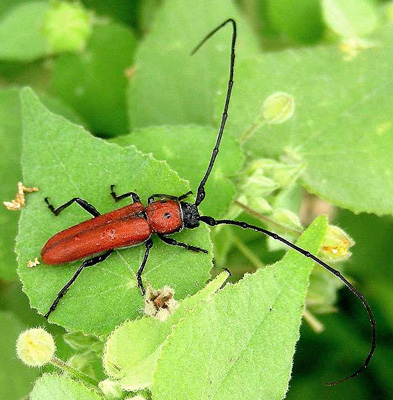
|
Return to Texas Entomology - Compiled by Mike Quinn

|
(mallows are its larval food plants)
Range: Western and southern Texas to southern Mexico (Hovore et al. 1987).
Adult Activity: September to early December (Hovore et al. 1987).
Larval Hosts: Larvae infest plants in the mallow family, Malvaceae. (Dan Heffern, pers. comm.)
Similar Species:
Eight species of Tylosis range from Arizona to Texas, south into southern Mexico (Monné & Hovore 2005).
Four species occur north of Mexico (Arnett et al. 2002)Texas Taxa:
Tylosis jimenezi Dugès
Tylosis maculatus LeConte
Tylosis oculatus LeConte
Etymology: Tylosis oculatus LeConte
tyl, =a, -ar, -o, =us (G). A knob, knot, pad
ocul, -i, -o, =us (L). An eye
Biography: John Lawrence Le Conte (1825-1883), entomologist - Wikipedia
References:
Arnett, R.H., Jr., M.C. Thomas, P.E. Skelley & J.H. Frank. (editors). 2002. American Beetles, Volume II: Polyphaga: Scarabaeoidea through Curculionoidea. CRC Press. 861 pp.
Hovore, F.T., R.L. Penrose & R.W. Neck. 1987. The Cerambycidae, or longhorned beetles, of southern Texas: a faunal survey (Coleoptera). Proceedings of the California Academy of Sciences, 44(13): 283-334, 20 figs.
Linsley, E.G. 1962. The Cerambycidae of North America. Part III. Taxonomy and classification of the subfamily Cerambycinae, tribes Opsimini through Megaderini. University of California Publications in Entomology, 20: 1-188.
Monné, M.A. & F.T. Hovore. 2005. Electronic Checklist of the Cerambycidae of the Western Hemisphere. 393 pp.
Vogt, G.B. 1949. Notes on Cerambycidae from the Lower Rio Grande Valley, Texas. Pan-Pacific Entomologist 25(3):137-144; (4):175-184.
01 Dec 2008 © Mike Quinn / Texas Entomology / Texas Beetle Information